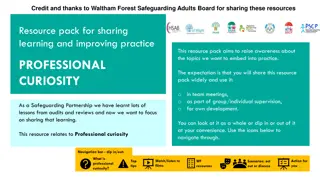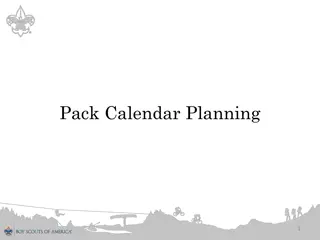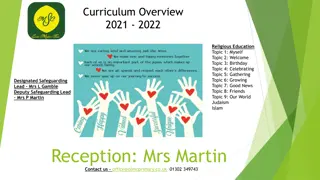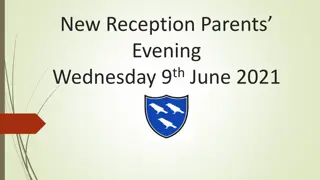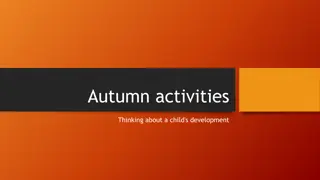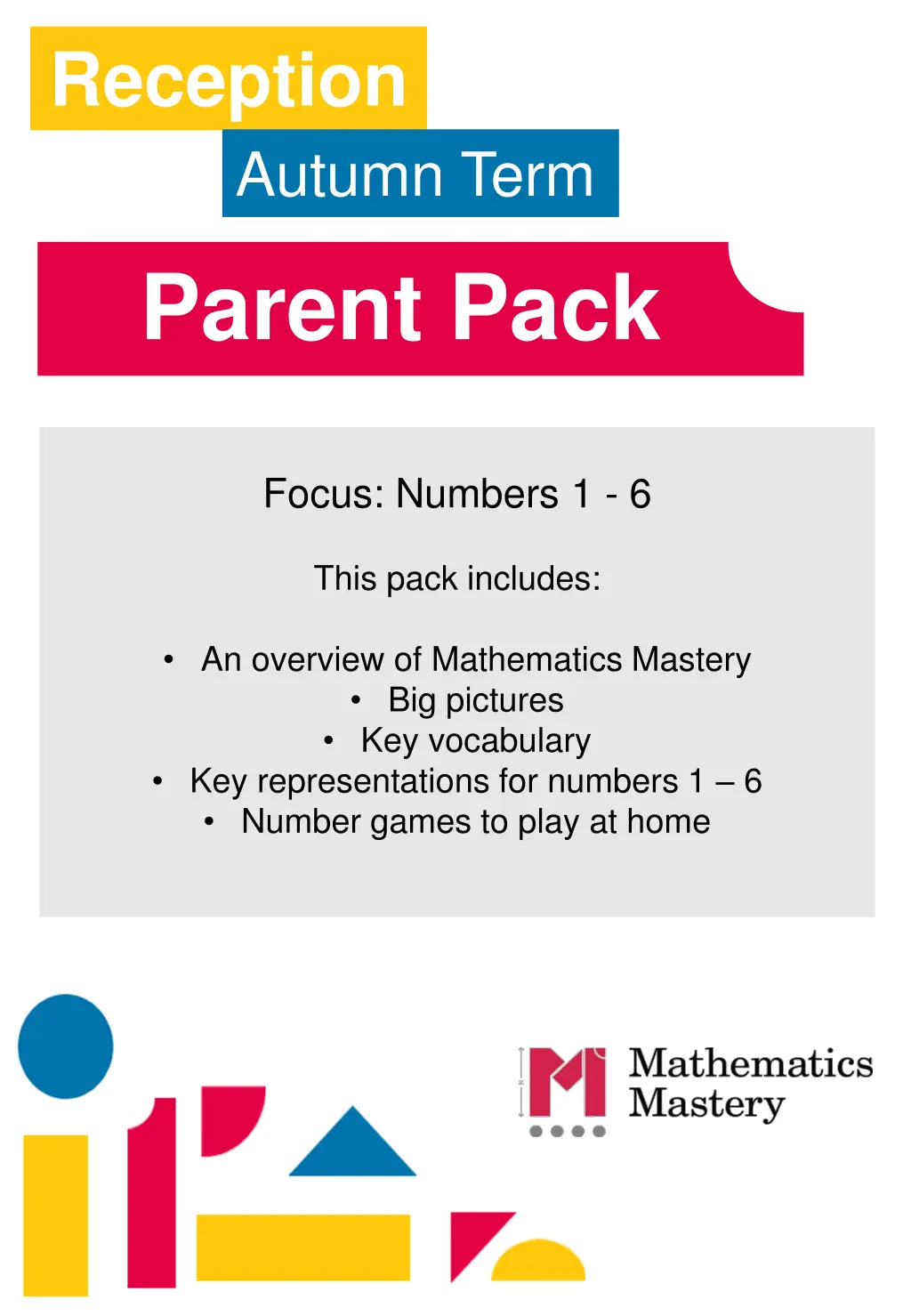
Developing Mastery in Mathematics: Reception Autumn Term Parent Pack Focus on Numbers 1-6
Enhance your child's mathematical skills with the Reception Autumn Term Parent Pack focusing on numbers 1 to 6. Discover the key concepts, vocabulary, and activities designed to build a deep understanding of mathematics through the Mastery approach. Help your child develop conceptual understanding, mathematical thinking, and communication skills to excel in math. Find tips for engaging your child in math learning at home and explore the curriculum map for the Autumn term covering addition, subtraction, measuring, shapes, patterns, and more.
Download Presentation

Please find below an Image/Link to download the presentation.
The content on the website is provided AS IS for your information and personal use only. It may not be sold, licensed, or shared on other websites without obtaining consent from the author. If you encounter any issues during the download, it is possible that the publisher has removed the file from their server.
You are allowed to download the files provided on this website for personal or commercial use, subject to the condition that they are used lawfully. All files are the property of their respective owners.
The content on the website is provided AS IS for your information and personal use only. It may not be sold, licensed, or shared on other websites without obtaining consent from the author.
E N D
Presentation Transcript
Reception Autumn Term Parent Pack Focus: Numbers 1 - 6 This pack includes: An overview of Mathematics Mastery Big pictures Key vocabulary Key representations for numbers 1 6 Number games to play at home
Mathematics Mastery What is Mastery ? The mastery approach to teaching mathematics is the underlying principle of Mathematics Mastery. Instead of learning mathematical procedures by rote, we want your child to build a deep understanding of concepts which will enable them to apply their learning in different situations. To achieve this we aim to develop pupils Conceptual Understanding, Mathematical Thinking and Language and Communication. (See diagram below). Representing concepts using objects, pictures, words and symbol; making connections between these Making conjectures, trying out specific examples, organising, comparing, looking for patterns and generalising Conceptual understanding Explaining, justifying and discussing using accurate mathematical language Mathematical problem solving Language & communication Mathematical thinking Central to learning mathematics Success for all At school we believe all pupils can achieve success in maths. We encourage pupils to have a growth mindset a belief that effort leads to success and that challenges are opportunities to learn. Here are a few tips to encourage your children at home with maths: Talk to your child about everyday maths Play games with them Value mistakes as learning opportunities Recognise that there is more than one way to work things out. Praise your child for effort over outcome. Avoid saying things like I m useless at maths .
Autumn focus: Numbers 1- 6 Reception - Autumn Curriculum Map Addition and subtraction Measure Shape and sorting Calend ar and time Early Pattern and early number Numbers to 6 mathematical experiences Count up to six objects One more or one fewer Order numbers 1 6 Conservation of numbers within 6 Estimate, order, compare, discuss and explore capacity, weight and lengths Describe and sort 3-D shapes Describe position accurately Days of the week and seasons Sequen ce daily events Classifying objects based on one attribute Comparing objects and sets Ordering objects and sets Recognise, describe, copy and extend colour and size patterns Count and represent the numbers 1 to 3 Estimate and check by counting Count up to six objects One more or one fewer Order numbers 1 6 Conservation of numbers within 6 This term one of our key focusses in Reception is developing understanding of numbers 1-6. Below are some of the key small steps pupils will be learning about: 1. Count 1, 2 and 3 reliably (using objects, images, sounds) 2. Create representations for numbers 1, 2 and 3. 3. Count numbers 1 6 reliably 4. Create representations for numbers 1 6 5. Place numbers 1 6 in order 6. Recognise numerals 1 6 7. Explore one more and one less 8. Addition and subtraction of numbers 1 6 9. Understand the concept of zero (0) Key vocabulary for Reception Numbers 1 6 one (1) two (2) three (3) four (4) five (5) six (6) how many count more fewer greater less same different next before after zero (0) none nothing part whole is equal to (=) plus altogether subtract minus The five frame is used to support early number skills. (Once pupils have a key understanding of numbers 1 5, they will move on to using a ten frame.)
Big Pictures What maths can you see? Discuss with your child at home using the key vocabulary on the previous page.
Try this at home workshop games Flip and Create 2-4 players one two three four five six more fewer less What you need: 12 dot cards with a variety of dot patterns representing numbers 1 to 6 (see the following page) and counters/buttons/stones/cubes etc. (6 per person required). How to play: Have the cards in a pile face don. The first player flips over one card. The rest of the players then use counters to replicate the arrangement of dots on his/her card and says the number out loud The dealer checks the results. The next player then flips over the next card and places it on top of the previous card. The players rearrange their counters. This continues until all the cards are used. Variations More or fewer: Each child can predict aloud whether the new card has more, fewer or the same number of dots as the previous card. The prediction is checked by the dealer, by observing whether counters need to be taken away or added. Create your own dot cards: Change the arrangements or increase/decrease the number of dots on the cards. Pairs 2 players What you need: 12 dot cards with a variety of dot patterns representing numbers 1 to 6 (see the following page.) How to play: Spread all the cards out face down. The first player turns over any two cards. If they are a pair (i.e. have the same number of dots), the player removes the cards and scores a point. If they are not a pair, both cards are turned back down in their places. The second player then turns over two cards and so on. When all the cards have been matched, the player with more pairs wins. Variations 1. Increase the number of pairs of cards used. 2. Use a greater number of dots on the cards. 3. Pair a dot card with a numeral card. one two three four five six



